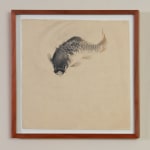

attributed, Kansetsu Hashimoto (1883-1945)
carp, ca 1930 - 1940
Sumi Ink and Color on Paper
12.5'' h X 13" w
14 3/4" X 15 1/4", framed
14 3/4" X 15 1/4", framed
Sold
My grandfather, Kuemon Endo, loved and collected Japanese art extensively. Our family’s cultural life orbited around the “way of tea” culture, called “tea ceremony” in the western world. He was...
My grandfather, Kuemon Endo, loved and collected Japanese art extensively. Our family’s cultural life orbited around the “way of tea” culture, called “tea ceremony” in the western world.
He was continually educating himself to master the culture. At one time in his life, he decided to learn how to draw with Sumi ink and brush. It was not that he wanted to become an artist, but rather to sharpen his eye to enjoy art more deeply. His teacher was Mr. Kansetsu Hashimoto. It was probably when Mr. Kansetsu settled in Kyoto around 1910-20 that he taught my grandfather. My grandmother told me so many times about the lessons, describing how my grandfather appreciated them. He also enjoyed the conversation with Mr. Kansetsu over dinners afterward.
One day I found a box full of drawings in an art storage facility of our century-old house. I realized that they were the practice drawings by my grandfather and some model drawings by his teacher, Kansetsu Hashimoto. To separate the two was very easy. About 95% of the drawings are by my grandfather, and the rest were by the teacher. The difference was pronounced. (sorry, Grnad-pa)
Those by the teacher are glorious. A very few masterful lines/brush strokes make an animal, a fish, or a landscape appear so alive on paper. It is not an explanation nor detailed depiction of an animal, a finish, so forth, but instead, as if it is a memory of those in one’s mind in a few strokes, memories in the artist’s mind.
This drawing is one of them.
* * Despite of the relationship and history between the artist and my grandfather, and it is not signed, Mitsui Fine Arts attributes it to Kansetsu Hashimoto. It is priced accordingly.
About the Artist
Japanese painter Kansetsu Hashimoto was born in Kobe city and settled in Kyoto around 1910 -20. He was one of the central figures of art circles in Taisho (1912 – 1926) and early Showa (1926 – 1989) era in Kyoto.
He was continually educating himself to master the culture. At one time in his life, he decided to learn how to draw with Sumi ink and brush. It was not that he wanted to become an artist, but rather to sharpen his eye to enjoy art more deeply. His teacher was Mr. Kansetsu Hashimoto. It was probably when Mr. Kansetsu settled in Kyoto around 1910-20 that he taught my grandfather. My grandmother told me so many times about the lessons, describing how my grandfather appreciated them. He also enjoyed the conversation with Mr. Kansetsu over dinners afterward.
One day I found a box full of drawings in an art storage facility of our century-old house. I realized that they were the practice drawings by my grandfather and some model drawings by his teacher, Kansetsu Hashimoto. To separate the two was very easy. About 95% of the drawings are by my grandfather, and the rest were by the teacher. The difference was pronounced. (sorry, Grnad-pa)
Those by the teacher are glorious. A very few masterful lines/brush strokes make an animal, a fish, or a landscape appear so alive on paper. It is not an explanation nor detailed depiction of an animal, a finish, so forth, but instead, as if it is a memory of those in one’s mind in a few strokes, memories in the artist’s mind.
This drawing is one of them.
* * Despite of the relationship and history between the artist and my grandfather, and it is not signed, Mitsui Fine Arts attributes it to Kansetsu Hashimoto. It is priced accordingly.
About the Artist
Japanese painter Kansetsu Hashimoto was born in Kobe city and settled in Kyoto around 1910 -20. He was one of the central figures of art circles in Taisho (1912 – 1926) and early Showa (1926 – 1989) era in Kyoto.
Provenance
Gift from the artist, Kansetsu Hashimoto to Mr. Kuemon Endo.It was inherited by his granddaughter Misako Mitsui.
It was acquired by Mitsui Fine Arts, in 2015.
Signup for our Newsletter
You will receive two emails a month from us. One introduces artworks and design works from Kyoto's hidden sources and the other is stories from Misako, sharing insights into Japanese culture.
* denotes required fields
为了回应您的查询,我们将根据我们的隐私政策处理您提供的个人数据。

